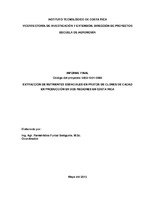Mostrar el registro sencillo del ítem
Extracción de Nutrientes Esenciales en Frutos de Clones de Cacao en Producción en dos Regiones en Costa Rica
| dc.contributor.author | Furcal-Beriguete, Parménides | |
| dc.date.accessioned | 2016-05-16T14:47:45Z | |
| dc.date.available | 2016-05-16T14:47:45Z | |
| dc.date.issued | 2015 | |
| dc.identifier.uri | https://hdl.handle.net/2238/6419 | |
| dc.description | Proyecto de Investigación. Código del proyecto: 5402-1801-0489 | es |
| dc.description.abstract | Costa Rica has traditionally been a producer of fine and aromatic cocoa, activity associated mainly to small farmers, but in 1978 the appearance of moniliasis disease significantly affected the cacao fruits, which, along with the distribution of genetic materials of poor quality, inadequate agronomic management and postharvest of the crop, they caused the decrease in the area planted and production, in contrast to the demand for this product in recent years in the national and international market. During the past 18 years the Program of Genetic Improvement of Cacao of the CATIE in Costa Rica, through improvement genetic tests, has selected tolerant material to this disease, conjugating as well with high yields. In the producing countries and in the areas of the rest of Central America, these materials were established for at least seven years with very good expectations. However, in the management of the crop it is continued using some of the traditional techniques applied to old varieties and hybrids, as well in the fertilization and mineral nutrition, that in our opinion, that agrees with the one of members of the Research Program and Transfer of Technology (PITTA) of cacao, would have to be adapted to the new high yields materials. Under this context and the research policy of the Costa Rica Institute of Technology (ITCR) is presented this proposal with the objective to analyze the extraction of essential elements in fruits of the cocoa clones in commercial expansion in the Central American region. The results show that one ton (1 000 kg) of dry seeds, including the crust of the fruit, of these clones extracts between 33.45 to 37.79 kg of N/t, between 40.35 and 50.64 kg of potassium (K)/t, and phosphorus in a rank of 7.33 to 8.37 kg of P/t. The information contained in this study is going to be used in future investigations in the area of cacao fertilization and nutrition, as well as for the elaboration of plans of fertilization in the commercial production system of cacao. | es |
| dc.description.sponsorship | Instituto Tecnológico de Costa Rica. | es |
| dc.language.iso | spa | es |
| dc.publisher | Instituto Tecnológico de Costa Rica. Vicerrectoría de Investigación y Extensión (VIE). Escuela de Ingeniería en Agronomía | es |
| dc.rights | acceso abierto | es |
| dc.rights.uri | https://creativecommons.org/publicdomain/zero/1.0/ | * |
| dc.subject | Fertilización | es |
| dc.subject | Nutrición | es |
| dc.subject | Cultivo | es |
| dc.subject | Remoción | es |
| dc.subject | Semillas | es |
| dc.subject | Cacao | es |
| dc.title | Extracción de Nutrientes Esenciales en Frutos de Clones de Cacao en Producción en dos Regiones en Costa Rica | es |
| dc.type | informe | es |



